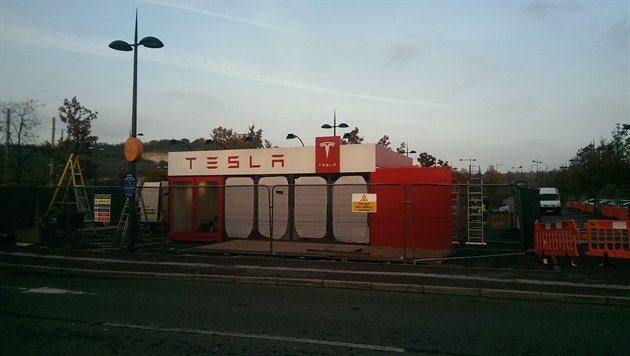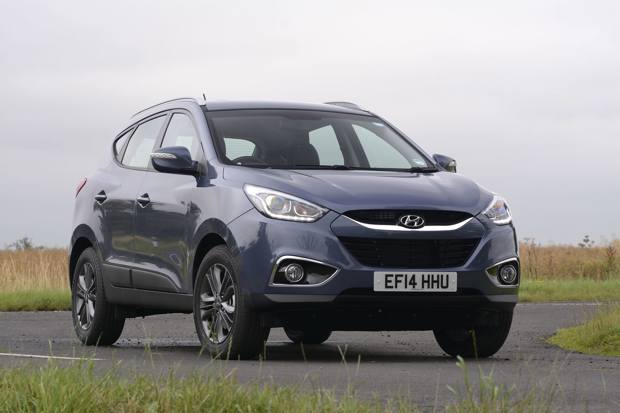ix35 joins the Our Cars fleet
We start six months with the revised and improved version of the popular Hyundai ix35 crossover.

Date: 8 July 2014 | Current mileage: 452 | Claimed economy: 53.3mpg | Actual economy: 44.3mpg
The ix35 is like part of the furniture when it comes to crossovers. It feels like it has been with us forever and is regularly near the top of buyers’ shortlists for cars of this type. But the truth is it was only launched back in early 2010, part of that initial wave of ‘crossovers’ that was kicked off with the Nissan Qashqai and included the Kia Sportage, Skoda Yeti and Ford Kuga. Just recently its undergone a facelift to keep up with the competition.
It’s also worth remembering that the ix35 was one of the models that dramatically shifted the way people thought of Hyundai. During the 2000s its image subtly changed from cheap to value for money. Instead of being sold on price alone, its cars started to become attractive in terms of value.
A combination of the list price and value-added benefits such as the five year/unlimited mileage warranty (which has more recently been extended to include five years free roadside assistance and five years of annual vehicle health checks). This plus much improved build quality, European driving characteristics and spec along with cheaper running costs made the ix35 an attractive package.
It meant that by the time the ix35 arrived, it was the right car at the right time. The combination of desirability, being the type of car everyone wanted and value for money meant that Hyundai in the UK was taken by surprise at the demand and it sold out almost instantly. From then on it was an uphill struggle to get enough cars to keep customers happy - six month waiting lists weren’t uncommon.
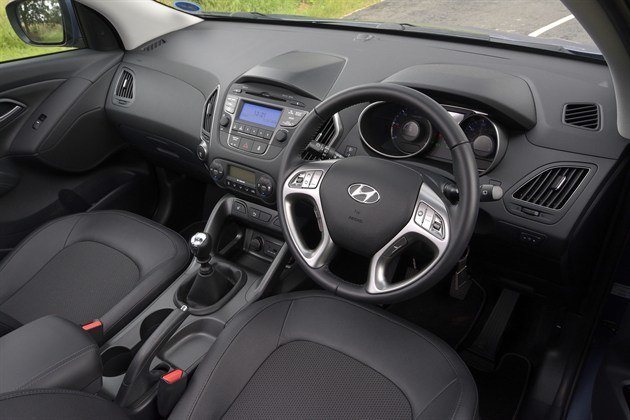
Neat design and a quality finish. The interior of the ix35 is also practical and spacious
This is a car that was our Car of the Year back in 2013. We give our awards based on what has been popular with our users over the course of the previous 12 months. And we hear an awful lot about the ix35, whether it’s because buyers have it on their shortlist and are asking us for more information via Ask HJ, writing owner reviews or submitting Real MPG readings. Our reader seems to love its mix of practicality and value for money.
The ix35 that we’ve gone for is the 1.7 CRDi with 115PS. Its a new generation of diesel engines and was first seen when the i40 was launched in 2010. One of the ways that Hyundai has added to its value for money proposition is by rushing through increasingly efficient engines to minimise VED and BIK tax costs. It means that this ix35 has CO2 emissions of 139g/km and is in VED band E (currently £130 a year).
Real MPG tells me that I should be expecting to get pretty much spot-on the official figures, which is very unusual. The range of submissions to Real MPG vary from 48.7mpg to 53.3mpg, giving an average of 49.3mpg. That’s 101 per cent of the official fuel consumption figure. The claimed figure doesn’t seem unrealistic, so it will be interesting to see how this stacks up in everyday driving. My routes tend to be a mixture of everything, so whatever I get will be a result of varied roads and routes.
When it comes to specification, this mid-range SE is well equipped without being over the top. There’s 17-inch alloy wheels, Bluetooth with voice recognition, heated front and rear seats, parking sensors and cruise control all as standard.
Fuel for thought
Petrol engine or diesel power? Which is the more cost effective option in the ix35?
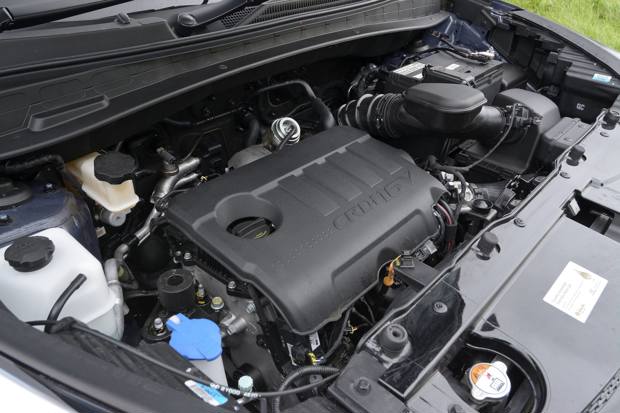
Date: 24 July 2014 | Current mileage: 976 | Claimed economy: 53.3mpg | Actual economy: 45.8mpg
In my first update, I mentioned how unusual it was for a manufacturer's official fuel consumption figures to be so close to what our users are achieving in everyday driving. Fuel consumption tests are conducted in laboratory-like conditions that bear scant resemblance to how we drive every day.
Manufacturers are under pressure to use every trick in the book to reduce the official CO2 figure, both through taxation incentives and regulations laid down by the European Commission. As the CO2 figure is tied to fuel consumption, optimising for CO2 creates an increasingly unrealistic mpg figure. Evidence of this is seen in Real MPG which shows that the difference between the official figures and what people are actually achieving has widened over the past five years.
But that doesn't appear to be the case with ix35. Owners report it can easily match (and in some cases exceed) the official fuel consumption figure. In the first few weeks that I’ve had this 1.7-litre CRDi, I’ve found that I’m getting between 42mpg and 44mpg, depending on the type of driving that I’m doing. That’s a little way off the official average, but you need to remember that this is a fresh-out-of-the-box car and it needs some miles under its belt before the engine settles down. Over time, I fully expect this to improve.
Another recent launch from Honestjohn.co.uk is a ‘fuel calculator’, which seeks to answer the perennial question: Should I buy a petrol or a diesel? It has also been updated to factor-in the increasing amount of alternatively fuelled cars that you can buy such as plug-in hybrids and full electric cars like the Nissan Leaf.

The 1.7-litre diesel makes a surprisingly cost-effective option
As well as comparing different models, you can also compare the same model with different engines to see whether you’re best suited to a petrol or diesel, depending on your mileage. Running the numbers on the 1.7-litre CRDi SE brings back some interesting results. I compared it with the petrol-powered 1.6 GDi SE, which is £1500 cheaper and 20PS more powerful.
Despite the price premium on the diesel, the 1.7-litre breaks even after just 46,000 miles (or 1682 days). That’s for a driver covering 10,000 per year. Increase that to 15,000 miles a year and it has paid for itself after 1182 days. As its capacity suggests, the 2.0-litre CRDi SE is also more powerful than the 1.7-litre, offering 136PS against 115PS.
But that additional power comes at some cost. As well as a an initial saving of £2900, the 1.7-litre is also £373 per year cheaper in fuel and tax costs, according to our figures adjusted for Real MPG. What’s more, I’ve found the 1.7-litre to be a great engine in spite of what the on-paper power output suggests. Its punchy enough at low revs, has a decent turn of speed and offers good refinement on the motorway. Towing on four-wheel drive are the clinchers. The 2.0-litre will tow 2000kg (as opposed to 1200kg) and has four-wheel drive (the 1.7-litre is two-wheel drive only).
And the ix35 isn’t a stranger to alternative fuels itself. Although not on the price lists yet, a zero-emissions hydrogen fuel cell version is currently going through testing. It converts hydrogen into electricity which then drives an electric motor. It gets from 0-62mph in 12.5 seconds and onto a top speed of 100mph. The only emission is water and it’s a real glimpse of the future.
ix35 - over to you...
Our readers have plenty of opinions on the Hyundai ix35. And here are just a few...
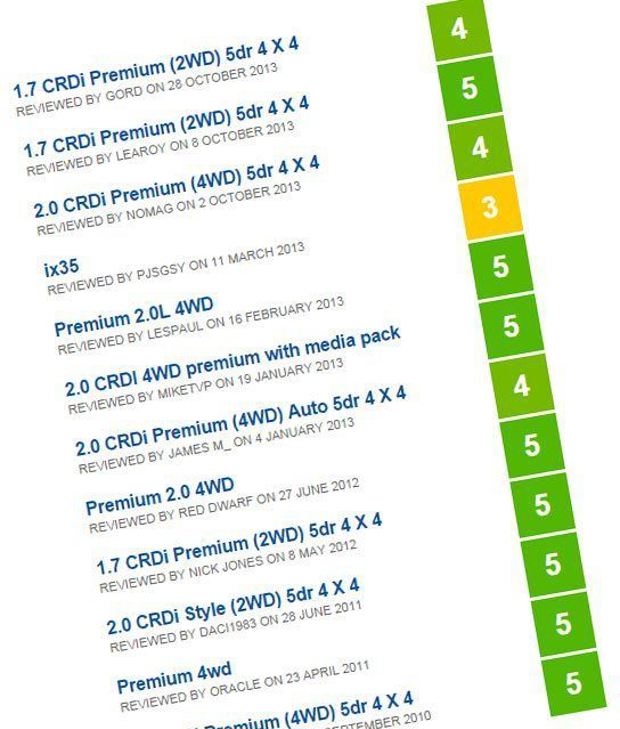
Date: 7 August 2014 | Current mileage: 1369 | Claimed economy: 53.3mpg | Actual economy: 46.7mpg
At the time of writing, 22 owners had submitted their honest reviews of the ix35. The vast majority of them are green on our colour-coding scale, which indicates an overall four or five out of five. That’s incredibly impressive.
There are a few concerns, however, and these tend to be centred around fuel consumption on the 2.0-litre CRDi, which unlike the 1.7-litre struggles to match the official figure. There are also criticisms of the light and unresponsive steering. On that second point, most of the complaints are from before 2013.
That’s important, as steering is an area that Hyundai has specifically looked to improve on. The ix35 is now available with what Hyundai calls a ‘Flex Steer' system that allows the driver to select from three modes - normal, comfort and sport - to tune the car’s steering. It will be interesting to see if, over time, this answers the criticisms about the car’s steering.
Here are some of the thoughts of the owners:
"I have driven approx 22k miles and the car is reliable and has comfortable seating. In May, four adults went across to Belgium through the tunnel (Bruge & Ypers etc) and we had no problems with the mechanics or comfort (until someone crashed into the parked car in Ypres, not too much damage but a pig to sort out with their insurers)."
"We bought this to replace my wife's Volvo C30. We had already tried the Volvo XC60, Honda CRV & Nissan Qashqai (all much too expensive) & the Kia Sportage (too cramped - I'm 6' 3" & my wife's 6'). So we were both delighted when we tried the ix35. There's loads of room & the fully glass roof gives a lovely light, airy feeling in the cabin. The seats are very comfortable & the driver's position is close to perfect. The car is fully loaded with satnav, bluetooth, reversing camera, voice recognition, heated front seats with partial leather. The engine is very willing & pulls extremely well from low revs & is already giving nearly 50 mpg after only 1,500 miles of mixed motoring."
"Great car, great price, fully loaded, mpg 50+ on first tank and a fantastic drive. The misses loves it and I must say I do too. I have no problems leaving the Merc at home and taking the ix35 instead - what more can i say?"
"It's a very smart looking car, especially the black and chrome which I have noticed attracts attention from the public when parked. The interior is like a tardis, loads of passenger room although as with most crossovers the boot space is ok at the most, it did manage 4 passengers and 4 cases for our holidays but the rear seat fold down does not work as well as some."
"Having now had the car for 18 months (17,000 miles), I feel able to comment. I wanted an MPV that had the 'footprint' of an average size saloon about 4.5 meters long, and 1.8 meters wide. It needed to carry a reasonable load, cruise at about 70 mph quietly and comfortably, be reliable and economical. It has basically met all these requirements. Have found that the returned economy can markedly deteriorate if you drive on the motorway at above 65 mph, but keep it in the mid sixties and it will return about 46 mpg. Drive at 50 mph and 50 mpg is possible. Interior finish is good. Equipment more than adequate. Drive both comfortable and responsive. Its exterior appearance is acceptable and does not look out of place with many other very much higher priced vehicles of a similar design - Audi Q3; BMW X3 etc. All in all no problems and will probably replace it with another when lease runs out in 18 months."
Have an ix35 of your own? Let us know what you think of it here.
What’s in a facelift?
This ix35 benefits from last year's upgrade. But can you tell the difference?
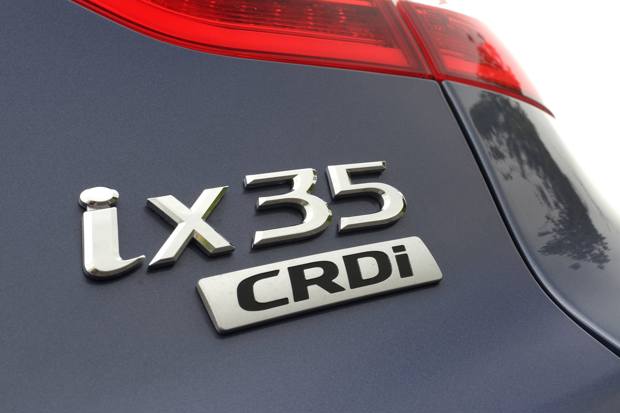
Date: 27 August 2014 | Current mileage: 1862 | Claimed economy: 53.3mpg | Actual economy: 46.9mpg
Last year the ix35 was treated to a mid-life upgrade, but can you tell the difference between the new and old cars?
The giveaway is the headlights. Those after the 2013 facelift have integrated LED daytime running lights, whereas those on sale before have standard units. Inside, the dials have been made easier to read and the audio system upgraded.
Visually, it as a nip-and-tuck upgrade that focussed on refining what the ix35 was already doing well, rather than making major changes. The biggest changes are to be found under the bonnet. My 1.7-litre was left unchanged (but after all it is a relatively new engine), but the 2.0-litre CRDi saw its output slashed from 181PS to 136PS.
That helped improve fuel consumption (41mpg versus 39mpg previously) and lower CO2 (179g/km versus 189g/km previously). Further changes include the introduction of a six-speed automatic transmission on the four-wheel drive 2.0-litre model.
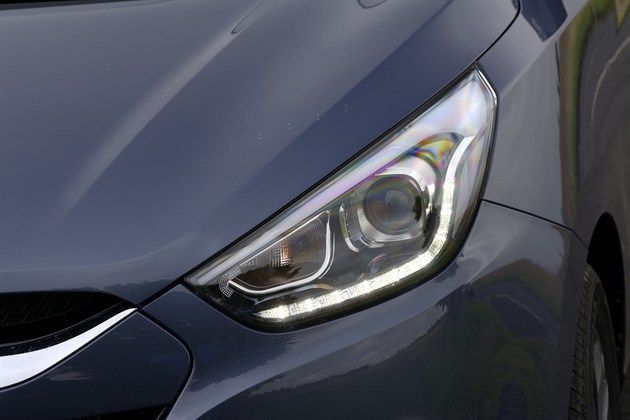
The revised ix35 gets new headlights and revised rear light clusters
Heated rear seats remain an unusual feature in a car of this size and I find that passengers are always really surprised when they find them, although with the relatively good summer that we’ve been having so far, there hasn’t really been an opportunity to make the most of them.
Astonishingly, the ix35 is now the oldest model in the Hyundai line-up and the clock is ticking down to the announcement of an all-new model. Going by Hyundai’s own model life cycles, we should see a new model revealed in 2015 - possibly as early as the spring. The Geneva Motor Show is in early March and it’s generally when a large number of new cars are announced.
Are you an owner of the current ix35? Let us know what you’d like to see in a new version of the car here.

Heated rear seats remain a rare feature on cars at this level
Hyundai: On the rise on the roads
I'm seeing more Hyundai models on the road than ever before - is it a sign of the changing times?

Date: 9 September 2014 | Current mileage: 2876 | Claimed economy: 53.3mpg | Actual economy: 47.2mpg
Just lately I’ve been taken aback by just how many Hyundai models there are on the roads. Maybe it’s because I’m now driving one and notice them just that little bit more, but just recently it seems that every other car behind me has those distinctive daytime running lights that are becoming Hyundai’s design signature.
So, using figures from our How Many Exist? section, I’ve done some digging to see just how many Hyundai cars - and the ix35 in particular - are on the roads. A surprising amount is the less than scientific answer…
Hyundai is a manufacturer that has sneaked up on everyone when it comes to volume. According to our records, there are now more than 537,000 Hyundai models on the road and this is rising rapidly. The manufacturer sailed through the half million mark sometime in 2012. To put that in some kind of context, that’s five times the number of Alfa Romeo cars on UK roads in less than a quarter of the time that Alfa Romeo has been around. That's pretty astounding.
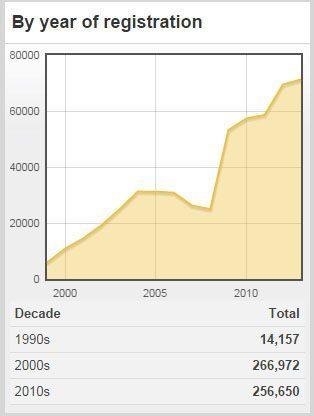
When it comes to the ix35 itself, the figures are no less surprising. On sale since early 2010, it has cranked-up more than 35,000 registrations, even though there were waiting lists . For comparison, there are 61,000 Ford Kuga on the road, though it has been on sale longer and benefitted from a new model being launched last year. It’s also twice the amount of all Hyundai cars left from the 1990s. And as you can see from the graph showing the total number of ix35s on the road, the rate of growth shows no sign of stopping. Last year - when the ix35 received its mid-life facelift - was the model’s best yet with just under 12,000 hitting the road.
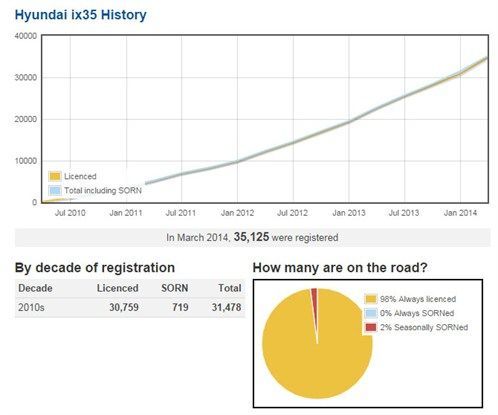
So why has the Korean company suddenly become so popular? As you’ll see from the graph above, scrappage in 2009 was the point at which everything changed, but in truth Hyundai has spent the past decade getting people thinking of its cars as a genuine alternative when buyers are thinking of a Ford Focus or Volkswagen Golf.
First there was the five-year 100,000-miles warranty, then the shift from low prices towards higher value. The break-through was when it started to design and build cars in Europe for Europeans (before this all cars for Europe were manufactured in Korea). Quality has improved considerably and now emissions are among the best in the industry too - a key consideration for those considering one as a company car.
So, it has taken just over 30 years to see more than half a million Hyundai cars on the road (sales began in the UK in 1982). How long will it take before there’s more than a million registered? At the current rate of growth (and scrapping of older cars), it’s entirely likely that it will take just six to seven years for Hyundai to add another half million cars. When it gets to that point, it will snapping at the heels of Toyota for total number of cars.
Practical enough for a zombie apocolypse
The ix35 gets a prominent role in zombie series The Walking Dead. But how practical is it for those with a few years left yet?

Date: 6 October 2014 | Current mileage: 3972 | Claimed economy: 53.3mpg | Actual economy: 50.1mpg
This week saw the return of one of my favourite TV shows, The Walking Dead, for its fifth series. If you haven't seen it, it's the story of a group of survivors battling their way through a zombie apocalypse. It's quite – okay very – gruesome, pretty violent and the kind of programme that comes with all kinds of warnings before the opening credits. Heart-warming telly it aint.
But there was one key member of the cast missing when I tuned in for the first episode of the new series: the survivors' ix35, or as they call it in the States, Tucson. Since the first episodes, it's been used as a getaway car, zombie crushing machine and hold-all for all manner of loads from weapons to medical supplies (though I'm going to overlook the fact that the series is set in 2010, yet they drive a 2013 model year Tucson).
In short it has been the perfect workhorse for fighting a zombie invasion. But its practicality isn't reserved just for those who are really up against it with the undead.
Back in the real world the boot is plenty big enough for a couple of full-size suitcases (as we found out recently when we went on holiday), while there's enough room to transport a fridge/freezer if you fold the seats down. A wide opening to the boot helps with big loads too, even if it is a little high off the ground.


While this version may not have four-wheel drive, I've so far not needed it. Of course that may change come the winter, as I live in a fairly remote area and snow often closes roads, but so far the decent ground clearance and sensible tyres have been more than enough to deal with muddy fields masquerading as car parks during the summer and the occasional farm track.
Unlike the ix35 that I'm running, I'm convinced that the Tucson in The Walking Dead is on run-flats. There's only so many times you can run down zombies and outrun looters on unmade roads without picking up a puncture. It also appears to be MUCH more fuel efficient than mine, despite using the thirstier 2.4-litre engine that we don't get in the UK. I don't recall seeing them filling it up once. On that subject, my fuel economy is improving rapidly as the engine beds in. I'm now averaging more than 50mpg.
The seats are proving comfortable, too. They're highly adjustable and supportive on longer trips – perfect when the only zombie on board is a snoozing passenger.
As for the survivors in The Walking Dead ending up with an ix35, it's no accident. It's an official tie-up between the series and Hyundai. The link-up has been recently marked in the States with The Walking Dead special edition which celebrates a decade of the graphic novels on which the TV series are based. They're all black (obviously) with red detailing and Walking Dead logos and a bootful of goodies designed to help you repel the zombie apocalypse. Should it ever happen.
The future of buying your next car?
Hyundai has launched a new way of buying a car that cuts out the dealer. But will it catch on?
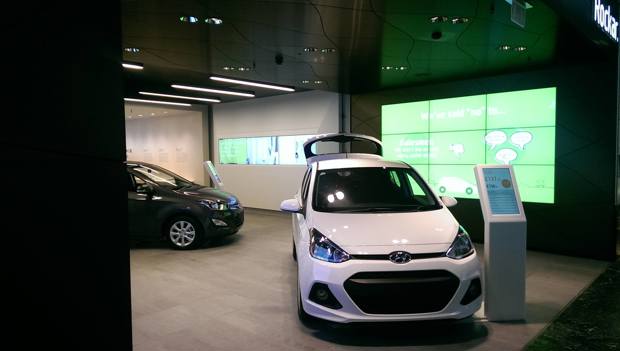
Date: 18 November 2014 | Current mileage: 4612 | Claimed economy: 53.3mpg | Actual economy: 50.2mpg
Back in one of my previous updates I spoke about how Hyundai's sales have exploded over the past few years and there's now more than half a million cars on the road. Now the firm aims to get to the buyers that other car makers can’t reach by opening a ‘store’ in Bluewater in Kent.
I say 'store', as it has much more in common with the Apple Store than your local Hyundai dealer - it’s all clean surfaces and touchscreens. Operated in conjunction with rockar.com, it allows buyers to research and test drive directly from Bluewater, cutting out a trip to a dealer. The idea is that as it’s convenient - i.e you don’t have to make a specific trip to a dealer - you’re more likely to take an interest when you may not have done so previously.
The traditional salesmen and women are replaced with ‘Rockar Angels’ who are on-hand to help, but not push you into buying. That’s because you can even do the whole deal - from start to finish - without speaking to anyone if you wish - rockar.com will sell you a car either with cash or on finance. A ‘no haggle’ policy means that everyone pays the same.
That ‘no haggle’ policy is an interesting one. When I checked out what it would cost to buy my Hyundai ix35 through rockar.com, it came out as £18,819 - a £1176 saving. That’s a sizeable discount (although at the time of writing, better deals were being offered on our site), but I wouldn’t want to do the entire transaction online. At the very least you need to have at least one test drive and a chance to get familiar with the car. If you’re outside of the Bluewater catchment area, this presents something of a problem - you’ll have to go to your local dealer anyway, which kind of defeats the purpose of the store. There is the possibility that of the concept takes off in the south, it will be extended to other parts of the UK.

And you’ll never be outside of the dealer network entirely - you need that back-up of a main dealer for servicing and repairs, although Hyundai says that you can take the car to Bluewater for servicing (it is then taken off-site to a dealer). And with Hyundai offering a five-year warranty, the chances are the relationship between an owner and the local dealer is longer than most.
It’s an interesting concept as new car sales remain one of those purchases that hasn't been totally revolutionized by the internet in the past decade. Almost every other industry has been totally transformed, from buying clothes to booking a holiday. And yet the traditional model of a manufacturer selling cars through a franchised physical premises seems as strong as ever. The chap who has set up Rockar has form in trying to shake-up the industry, he was the founder of the before-its-time jamjar.com, which sold cars purely online.
There will be a lot of keen eyes focussed on this concept and, should it take off, you can expect to see it copied by car manufacturers in shopping centres up and down the country. Interestingly, as I walked back to my car, I spotted Tesla setting up this. Seems the electric car company has similar ideas to Hyundai...
